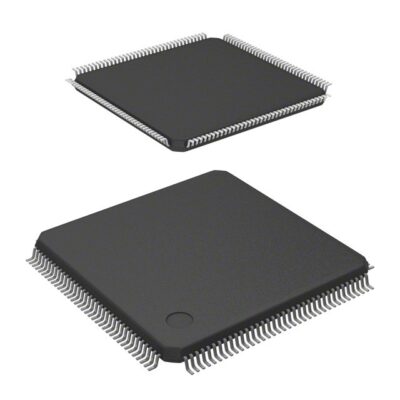STM32F427ZIT6
Part Number: STM32F427ZIT6
Manufacturer: STMicroelectronics
Description: IC MCU 32BIT 2MB FLASH 144LQFP
Shipped from: Shenzhen/HK Warehouse
Stock Available: Check with us
ICRFQ.com - Electronic Components Distributor in China Since 2003

Part Number: STM32F427ZIT6
Manufacturer: STMicroelectronics
Description: IC MCU 32BIT 2MB FLASH 144LQFP
Shipped from: Shenzhen/HK Warehouse
Stock Available: Check with us
| Datasheet | |
|---|---|
| Category | Integrated Circuits (ICs) |
| Family | Embedded – Microcontrollers |
| Manufacturer | STMicroelectronics |
| Series | STM32 F4 |
| Packaging | Tray |
| Part Status | Active |
| Core Processor | ARM? Cortex?-M4 |
| Core Size | 32-Bit |
| Speed | 180MHz |
| Connectivity | CAN, EBI/EMI, I2C, IrDA, LIN, SPI, UART/USART, USB OTG |
| Peripherals | Brown-out Detect/Reset, DMA, I2S, POR, PWM, WDT |
| Number of I/O | 114 |
| Program Memory Size | 2MB (2M x 8) |
| Program Memory Type | FLASH |
| EEPROM Size | – |
| RAM Size | 256K x 8 |
| Voltage – Supply (Vcc/Vdd) | 1.8 V ~ 3.6 V |
| Data Converters | A/D 24x12b, D/A 2x12b |
| Oscillator Type | Internal |
| Operating Temperature | -40°C ~ 85°C (TA) |
| Package / Case | 144-LQFP |
| Supplier Device Package | * |
The STM32F427ZIT6 is a powerful microcontroller based on the ARM Cortex-M4 architecture. It offers a wide range of features and capabilities, making it suitable for various embedded systems and IoT applications. This comprehensive guide aims to provide you with a detailed overview of the STM32F427ZIT6 microcontroller, its specifications, key features, and programming guidelines.
Introduction to ARM Cortex-M4 Architecture: The STM32F427ZIT6 microcontroller is based on the ARM Cortex-M4 processor core. The Cortex-M4 is a 32-bit embedded processor architecture designed specifically for microcontroller applications. It offers a powerful and efficient processing unit with a high level of performance and low power consumption.
The Cortex-M4 architecture includes features such as a Harvard architecture with separate instruction and data buses, a 3-stage pipeline, a floating-point unit (FPU), and a nested vectored interrupt controller (NVIC). These features contribute to the microcontroller’s ability to handle real-time operations, digital signal processing, and complex control algorithms.
The STM32F427ZIT6 microcontroller incorporates a range of features and specifications that make it suitable for a wide range of applications. Some of the key features include:
These specifications provide a solid foundation for developing complex applications requiring high processing power, connectivity, and control capabilities.
The STM32F427ZIT6 microcontroller is available in different package options, each offering a specific pinout configuration and physical form factor. The most common package for this microcontroller is the LQFP (Low Profile Quad Flat Package). The pinout and package options may vary, but here is an example of the pinout for the LQFP144 package:
The STM32F427ZIT6 microcontroller provides a set of GPIO pins that can be configured as general-purpose input or output. These pins allow you to interface with external devices and control various signals. Key features of GPIO include:
The STM32F427ZIT6 microcontroller includes advanced timer units that provide precise timing control and support Pulse Width Modulation (PWM) generation. Key features include:
The STM32F427ZIT6 microcontroller integrates a high-resolution Analog-to-Digital Converter (ADC) module. This module allows you to sample and convert analog signals into digital values for processing. Key features of the ADC include:
The STM32F427ZIT6 microcontroller supports various serial communication interfaces, enabling communication with other devices. Key interfaces include:
These interfaces provide flexible options for connecting and communicating with external devices such as sensors, displays, and other microcontrollers.
DMA (Direct Memory Access)
The STM32F427ZIT6 microcontroller incorporates a Direct Memory Access (DMA) controller, which enables efficient data transfer between peripherals and memory without CPU intervention. Key features of DMA include:
Using DMA can offload CPU overhead and improve overall system performance, particularly in scenarios where high-speed data transfer is required.
Interrupts and NVIC (Nested Vector Interrupt Controller)
The STM32F427ZIT6 microcontroller features a Nested Vector Interrupt Controller (NVIC), which manages interrupts generated by various peripherals. Key features of interrupts and the NVIC include:
The NVIC manages interrupt requests and prioritizes them based on their priority levels, ensuring efficient handling of interrupts within the microcontroller.
These core peripherals and features of the STM32F427ZIT6 microcontroller provide essential capabilities for interacting with the external environment, controlling timing, processing analog signals, communicating with other devices, optimizing data transfer, and managing interrupts effectively.
The STM32F427ZIT6 is a highly versatile microcontroller, boasting exceptional performance, robust peripheral support, and a host of rich features tailored for a diverse range of embedded applications. By immersing yourself in this comprehensive guide, you will acquire an in-depth understanding of the STM32F427ZIT6, empowering you to effectively develop projects and harness its full potential.
To delve deeper into the world of STM32F427ZIT6 and place an order, connect with us at ICRFQ, a renowned electronic component distributor based in China. Our expertise and reliable services will ensure a seamless experience in procuring the STM32F427ZIT6 for your development needs. Take the next step in unleashing the power of the STM32F427ZIT6 by reaching out to us at ICRFQ today.
WhatsApp us